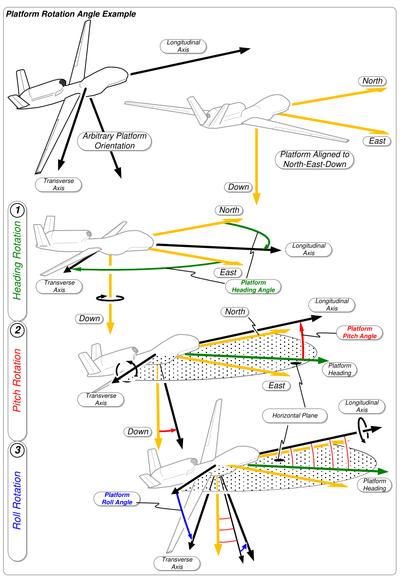[References]
An aircraft in flight is free to rotate in three dimensions:
- pitch, nose up or down about an axis running from wing to wing;
- yaw, nose left or right about an axis running up and down;
- roll, rotation about an axis running from nose to tail.
- The axes are alternatively designated as lateral, vertical, and longitudinal.
- These axes move with the vehicle and rotate relative to the Earth along with the craft.
- These definitions were analogously applied to spacecraft when the first manned spacecraft were designed in the late 1950s.
These rotations are produced by torques (or moments) about the principal axes. On an aircraft, these are produced by means of moving control surfaces, which vary the distribution of the net aerodynamic force about the vehicle's center of mass. Elevators(moving flaps on the horizontal tail) produce pitch, a rudder on the vertical tail produces yaw, and ailerons (flaps on the wings that move in opposing directions) produce roll. On a spacecraft, the moments are usually produced by a reaction control systemconsisting of small rocket thrusters used to apply asymmetrical thrust on the vehicle.
Principal axes[edit]
- Normal axis, or yaw axis — an axis drawn from top to bottom, and perpendicular to the other two axes. Parallel to the fuselage station.
- Lateral axis, transverse axis, or pitch axis — an axis running from the pilot's left to right in piloted aircraft, and parallel to the wings of a winged aircraft. Parallel to the buttock line.
- Longitudinal axis, or roll axis — an axis drawn through the body of the vehicle from tail to nose in the normal direction of flight, or the direction the pilot faces. Parallel to the waterline.
Normally, these axes are represented by the letters X, Y and Z in order to compare them with some reference frame, usually named x, y, z. Normally, this is made in such a way that the X is used for the longitudinal axis, but there are other possibilities to do it.
Vertical axis (yaw)[edit]
The vertical yaw axis is defined to be perpendicular to the wings and to the normal line of flight with its origin at the center of gravity and directed towards the bottom of the aircraft. Yaw moves the nose of the aircraft from side to side. A positive yaw, or heading angle, moves the nose to the right.[1][2] The rudder is the primary control of yaw.[3]
Lateral axis (pitch)[edit]
The pitch axis (also called lateral or transverse axis[4]) passes through the plane from wingtip to wingtip. Pitch moves the aircraft's nose up and down. A positive pitch angle raises the nose and lowers the tail. The elevators are the primary control of pitch.[3]
Longitudinal (roll)[edit]
The roll axis (or longitudinal axis[4]) passes through the plane from nose to tail. The angular displacement about this axis is called bank.[3] The pilot changes bank angle by increasing the lift on one wing and decreasing it on the other. A positive roll angle lifts the left wing and lowers the right wing. Theailerons are the primary control of bank. The rudder also has a secondary effect on bank.[citation needed]


No comments:
Post a Comment